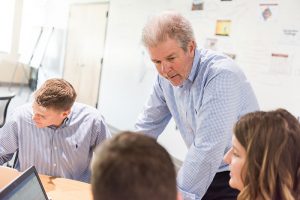When it comes to inspiring entrepreneurs to reach their fullest potential, Gib Mason–Program Director for UMBC’s Entrepreneurship, Innovation,and Leadership (EIL) Graduate Program–understands what’s at stake. We sat down and chatted with him about his career, what it takes to be a successful entrepreneur, and how UMBC helps professionals claim their future through an innovative curriculum.
Can you tell us a little about your career path and how that led you to UMBC?
When I think about my career path, it’s a unique and interesting kind of winding road to ultimately end up as a graduate program director of the Master’s of Professional Studies in Entrepreneurship, Innovation, and Leadership at UMBC.
As a leader who was able to spend time in multiple different industries and in various leadership roles, there’s very little that I know a lot about, but there’s a lot that I know a little bit about. The learning that has come from these different types of experiences has shaped me into the leader I am today. It gives me the opportunity to support the learning of leadership and innovation in others, and certainly helps me to paint a clear picture of what it means to be an entrepreneur.
What would you say is unique about UMBC’s Graduate Program in EIL?
I’m fairly certain that we’re not the first university to put the concepts of entrepreneurship, innovation, and leadership together in a master’s program. What I can tell you is I’m fairly certain that we are the first to have created three specific pathways where students can tailor their education to their interests. These pathways include Entrepreneurship, Intrapreneurship, and most importantly, in terms of differentiation, Socialpreneurship.
Can you talk about the course that you teach?
I teach Entrepreneurial Mindset, which is a course designed to get future entrepreneurs in a frame of mind that allows them to get through ambiguous times at the beginning of their entrepreneurial career. Some of the goals of this course is to help students carve a path to find the root of their passion, to understand where their ambition lies, and to provide them with the tools necessary for applying entrepreneurial thinking in their work and life.
What are some of the unique elements that students may bump into while taking this course?
Well, I can tell you that several students, usually two to three weeks in, tell me they feel things are so ambiguous that they don’t know which way is up or down. And, I say in response, “Awesome!” Because that’s exactly what it feels like when you’re out in the real world as entrepreneurs. Which way is up? Being an entrepreneur can feel like you’re swimming with your head underwater. I try to recreate these types of environments in the classroom so that students begin to get a feel for what it takes to do the work that they’re eager to do.
 In what ways, does the program/course prepare its students to be entrepreneurs?
In what ways, does the program/course prepare its students to be entrepreneurs?
What we provide is an engaging learning environment that uses a lot of live case studies. So, instead of providing students with case studies that have a beginning, a middle, and an end, and they try to solve for that, we have them bring actual challenges they are facing to the class.
The incredible horsepower that comes into the room every evening with 15-20 students provides invaluable insights.
Can you speak about student interaction in the classroom?
Every person that comes into the classroom is bringing something with them. They’re bringing something of value. They’re bringing a group of experiences we refer to as biographical diversity.
In each class, we reflect on the takeaways from the last session. We ask ourselves: how were we able to apply what we learned last session into our businesses or into our other work? What were our greatest takeaways? How are we implementing what we’re learning? In a typical session, we spend 30 to 45 minutes at the beginning of the class reflecting. The storytelling that goes along with that is rich and invigorating for everyone in the classroom.
What can students expect out of the program?
One of the great takeaways is the opportunity to get to know and create relationships with the instructors that are driving this program. I’ve had the opportunity over the last several years, and in building the Center for Leadership and Innovation at UMBC Training Centers, to surround myself with dozens of some of the coolest, most influential dynamic entrepreneurs, innovators, and leaders that work with us directly. Fortunately, many of them have committed to being the instructors in the EIL graduate program.
Additionally, students gain access to an incredible experience. They are offered the opportunity to learn from the people in the trenches. The ones rolling up their sleeves, getting dirt on their boots, and having multiple failures and successes. Students have that opportunity to practice in the classroom on a regular basis. And, not just with instructors, but with peers. The big takeaway from the program is the incredible amount of practical experiences shared. Students gain an upper edge. They’ve forged new relationships with peers, as well as very influential instructors, facilitators, and professors.
It’s an opportunity of a lifetime.
According to the Labor Insights employer-demand tool, the Baltimore-Columbia-Towson metro area has a higher demand than average for jobs requiring entrepreneurship, leadership and innovation skills, with over 12,000 job postings listing one of these skills. Employers hiring for these skillsets include companies such as Northrop Grumman, Oracle, Johns Hopkins University and T. Rowe Price.
